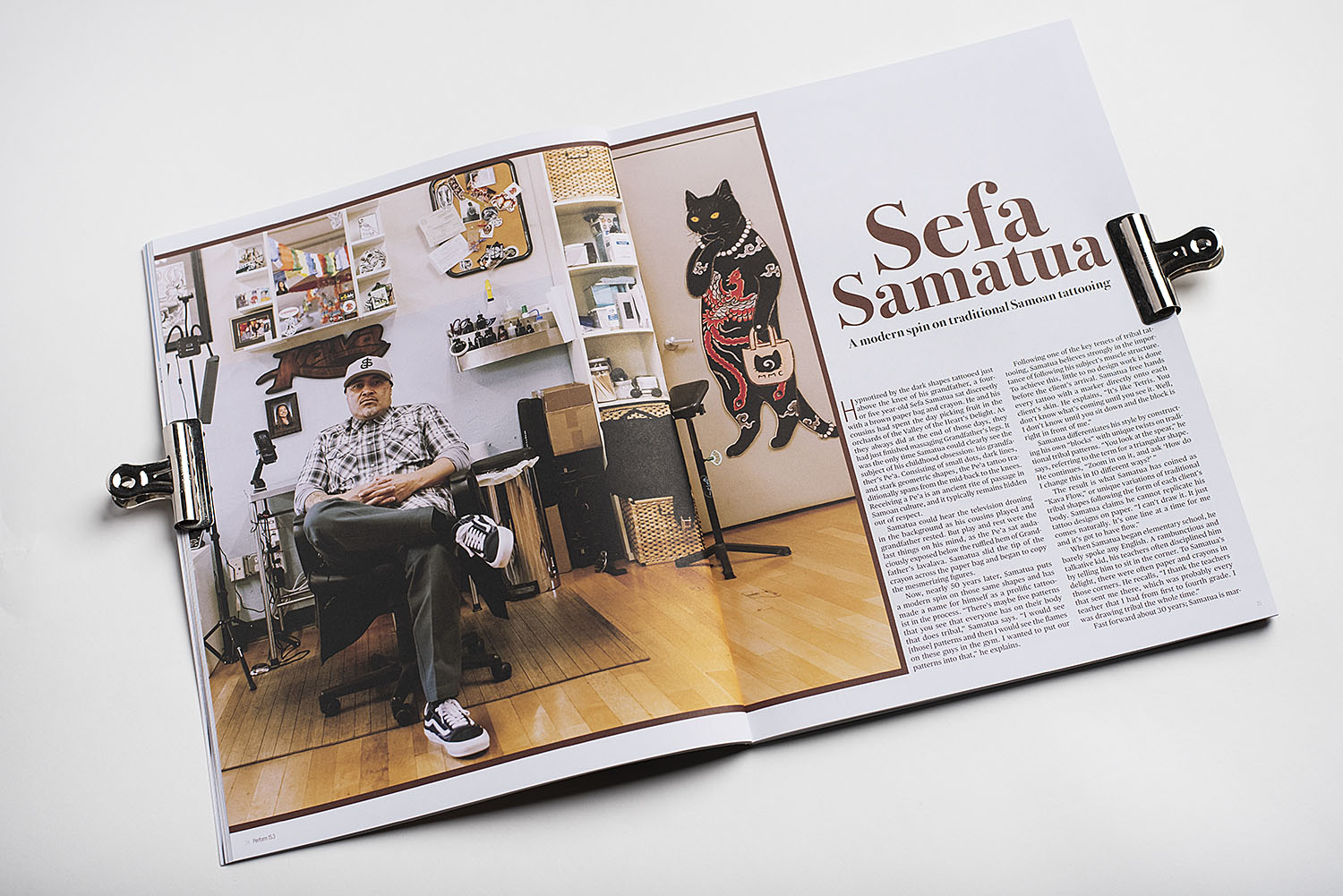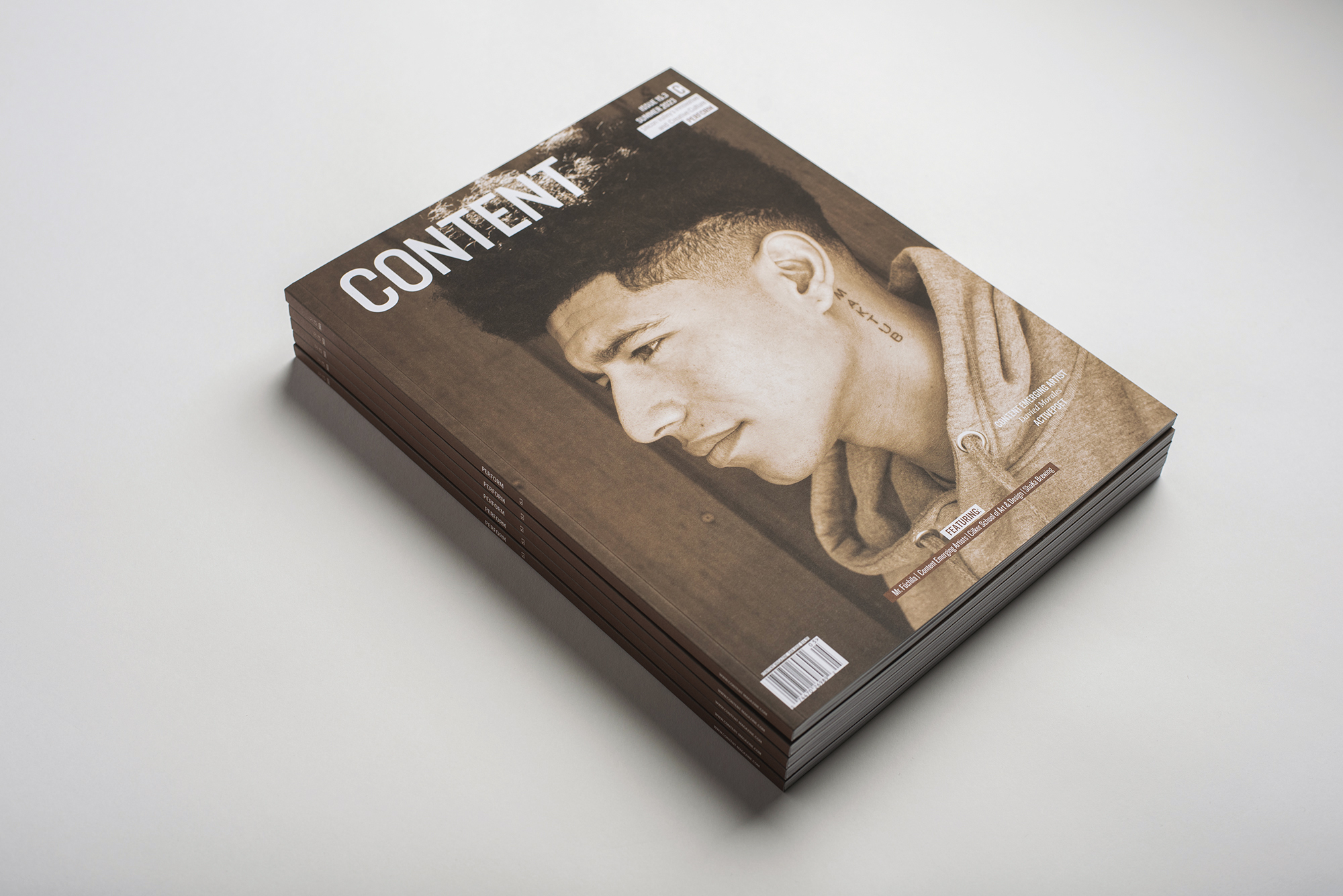
Hypnotized by the dark shapes tattooed just above the knee of his grandfather, a four- or five year-old Sefa Samatua sat discreetly with a brown paper bag and crayon. He and his cousins had spent the day picking fruit in the orchards of the Valley of the Heart’s Delight. As they always did at the end of those days, they had just finished massaging Grandfather’s legs. It was the only time Samatua could clearly see the subject of his childhood obsession: his grandfather’s Pe’a. Consisting of small dots, dark lines, and stark geometric shapes, the Pe’a tattoo traditionally spans from the mid-back to the knees. Receiving a Pe’a is an ancient rite of passage in Samoan culture, and it typically remains hidden out of respect.
Samatua could hear the television droning in the background as his cousins played and grandfather rested. But play and rest were the last things on his mind, as the Pe’a sat audaciously exposed below the ruffled hem of Grandfather’s lavalava. Samatua slid the tip of the crayon across the paper bag and began to copy the mesmerizing figures.
Now, nearly 50 years later, Samatua puts a modern spin on those same shapes and has made a name for himself as a prolific tattooist in the process. “There’s maybe five patterns that you see that everyone has on their body that does tribal,” Samatua says. “I would see [those] patterns and then I would see the flames on these guys in the gym. I wanted to put our patterns into that,” he explains.
Following one of the key tenets of tribal tattooing, Samatua believes strongly in the importance of following his subject’s muscle structure. To achieve this, little to no design work is done before the client’s arrival. Samatua free hands every tattoo with a marker directly onto each client’s skin. He explains, “It’s like Tetris. You don’t know what’s coming until you see it. Well, I don’t know until you sit down and the block is right in front of me.”
Samatua differentiates his style by constructing his own “blocks” with unique twists on traditional tribal patterns. “You look at the spear,” he says, referring to the term for a triangular shape. He continues, “Zoom in on it, and ask ‘How do I change this in 10 different ways?’ ”
The result is what Samatua has coined as “Kava Flow,” or unique variations of traditional tribal shapes following the form of each client’s body. Samatua claims he cannot replicate his tattoo designs on paper. “I can’t draw it. It just comes naturally. It’s one line at a time for me and it’s got to have flow.”
When Samatua began elementary school, he barely spoke any English. A rambunctious and talkative kid, his teachers often disciplined him by telling him to sit in the corner. To Samatua’s delight, there were often paper and crayons in those corners. He recalls, “I thank the teachers that sent me there, which was probably every teacher that I had from first to fourth grade. I was drawing tribal the whole time.”
Fast forward about 30 years; Samatua is married and a father. Humble Beginnings Tattoo, a tattoo shop on San Jose’s Alameda, began to make a name for itself in the world of tribal tattooing. Orly Locquiao, the shop’s owner, encouraged Samatua to pursue the craft he was passionate about.
“He gave me a machine. He gave me a few pointers. And I just went from there,” Samatua recalls. He began tattooing people where so many other artists get their start, in his garage. His clients would lay on cinder blocks with a pillow as he tattooed them with his daughter by his side. Soon, Samatua quit his nine-to-five and joined Locquiao at Humble Beginnings.
The root of Samatua’s inspiration traces back to that fateful summer examining his grandfather’s Pe’a. The first time his grandfather noticed Samatua eyeing the body art, he covered it to prevent Samatua from seeing it. But that didn’t stop Samatua.
“When he’d sleep, I would lift his shirt up a little bit so I could see his stomach,” he shares. “Then he would turn sometimes on the side or on his stomach and I would see the back. The inside is the best part,” Samatua says, recalling the insides of Grandfather’s thighs. He continues, “It’s where the teeth are. It’s all black and all you see are these spikes. That’s what I love. That’s where I got all the elements, from his body.”
Eventually, Grandfather empathized with his grandson’s curiosity and began to deliberately pull up his lavalava and allow Samatua to draw. “It was like suffocating …and then finally, you could breathe,” Samatua explains. “That’s what it felt like. All this weight came off my shoulders trying to draw this,” he describes.
In 2016, the artist moved from Humble Beginnings to Japantown’s State of Grace. Fifteen years into his career, Samatua has never looked back.
Instagram:
sef_kavafornia & kavafornia


